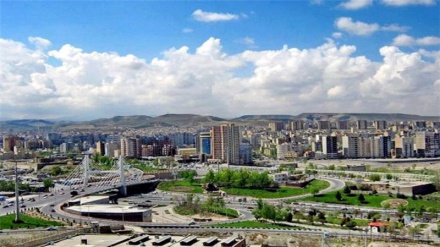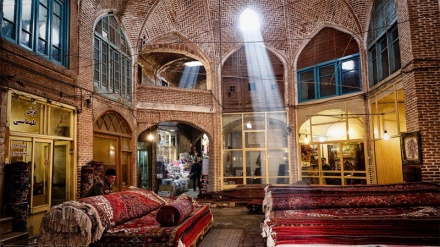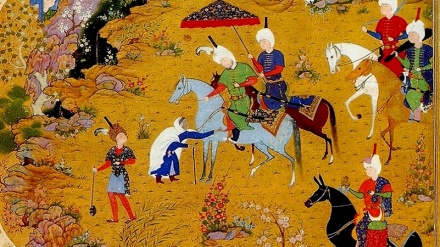Tabriz, 2018 (17)
Welcome to this week's episode of the series "Tabriz, 2018". Today, we become familiar with a number of tourist attraction sites of the city of Tabriz.
Every given city maintains a number of small and large tourist attraction sites, distinguishing it from other cities and regions. Whenever one speaks of traveling to the city of Tabriz, the first sight-seeing location which springs to mind in Eil-Goli Park, which glitters like a gem in this city and is considered to be the largest recreational site of the city of Tabriz.
This huge park is situated on foothills, southeast of the city of Tabriz. It is a recreational location, similar to ancient Iranian orchards, with a lake and a palace situated in the middle of this park. This park maintains a number of other attractions such as a funfair, a mini-golf center, a skating complex, a number of coffee shops, restaurants, vending stalls, and a hall. Rowing in this park's lake, strolling across the park, picnics in this ever-green and fresh garden, and attending the park's funfair, are also among the recreational activities that the visitors to this park, engage in.
This attractive park has been enlisted among Iran's national heritages in the year 2009.
This park's lake is one of the main parts of this large sight-seeing location, granting especial beauty to this recreational complex. This lake covers 5.5 hectares and can accommodate up to 720,000 cubic meters of water. The lake is 200 meters in length and 200 meters in width. The maximum depth of the lake stands at twelve meters, however in its eastern corner, the water depth varies from 3 to 6 meters. In the past, the lake maintained larger dimensions. However, currently due to the presence of a number of gardens, surrounding this lake, the lake's dimensions have been reduced. The water of this lake originates from one of the offshoots of River Liqvan, pouring into this lake from its southeastern corner. Moreover, the water current of the artificial waterfalls, which run across a foothill next to the lake, pour into this astounding lake. Meanwhile, Eil-Goli Palace is situated in the middle of this lake.
This palace is a two-story, octagonal building, which is enlisted among the symbols and epitomes of the city of Tabriz. It is a beautiful structure with a small dome, which was among the recreational centers of Qajarid courtiers until the waning years of the rule of this dynasty. Currently, it has turned into a restaurant and a reception hall, hosting passengers and locals who pay a visit to this unique park. This palace is linked to other parts of the park via a street which runs next to the southern corner of the lake.
The city of Tabriz has long been a center for acquirement of knowledge and science. The remains of a historical university in this city, proves this remark. This ancient university campus is one of the historical monuments of Tabriz, which has been constructed based on Azari architectural style.
Roughly 700 years ago, a university was built in Tabriz under the name of Rashid Ed-Din Fazlullah Hamedani, who was the then ruler of this city. At the time, this university consisted of four faculties, which were located at the four corners of the university campus. According to the writings of famed historians and tourists, this university campus was quite vast in size, consisting of several buildings, including a mosque, a school, a hospital, and a library. This university campus was fenced. Based on a letter that the then ruler of Tabriz has sent for his two sons, 6,000 students studied in this university, and all of the common sciences of that era were taught at the said university campus. The then ruler of Tabriz had gathered craftsmen, artists, physicians, and religious scholars from different parts of the country for acquirement of knowledge at this university, and had accommodated four hundred Ulema, theologians, and hadith scholars in residential units affiliated to this university. He had also invited 50 skilled physicians from China, India, and other regions of Iran for serving at the university campus hospital.
The city of Tabriz, like many other Iranian cities is home to a number of religious minorities, who live peacefully next to Muslims. Hence, there are a number of churches in this city and its outskirts, with the "Maryam-e Moqaddas" Church being the largest and oldest church of the city of Tabriz.
This church has a large courtyard, filled with trees. The construction of this church started in 1782 AD and ended in 1785 AD. In the wake of an earthquake that jolted Tabriz in the year 1780 AD, the former building of this church was razed to the ground, with the current church being constructed on the ruins of the previous building with the construction materials, remaining from the former edifice. The current church has been constructed based on Armenian architectural style and is in the form of a cross. The main gateway of the church is in front of the church's altar. At the top of the main gateway of the church, two small inscriptions made of marble have been installed which specify the date of foundation of this church in Armenian language. In the interior of the church, there are four thick stone-made pillars, over the top of which the central dome has been placed. The church's altar is situated 80 centimeters higher than the church's floor, and is separated from other parts of the church with a wooden fence. The altar covers twelve square meters.
Moreover, there are a number of tombs in and out of this church, including the tomb of a priest, which is situated in the interior of the church, dating back to 18th Century AD.
MR/ME


